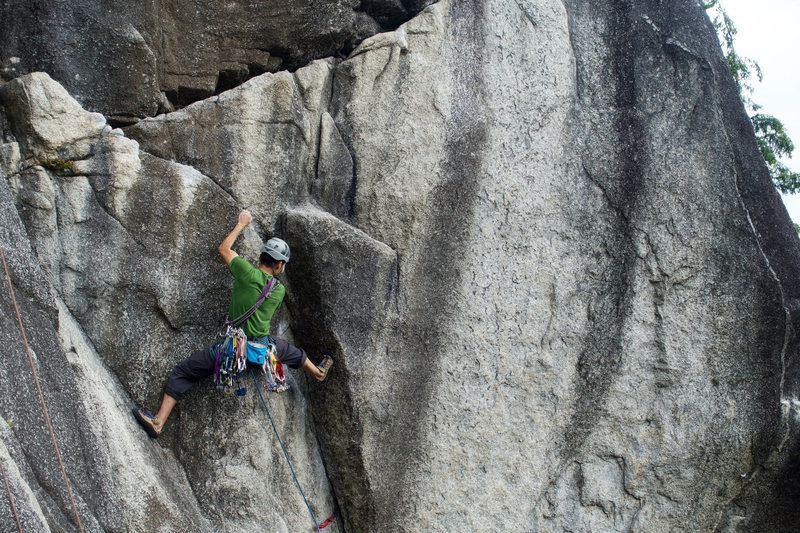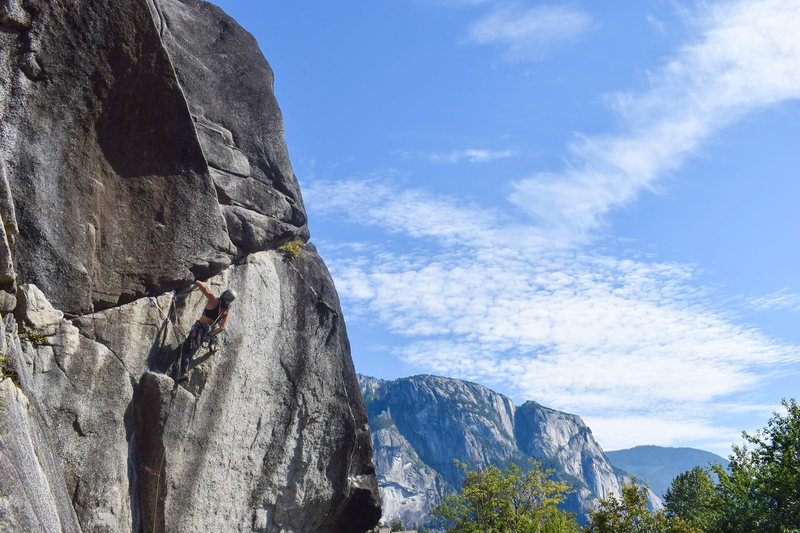Structural Failure of Black Diamond Ultralight Camalot Size 0.4 Resulting in Injury
|
|
reboot wrote: TD;LR: It has little to do w rigidity of the stem, IMO. Agreed. Even if it was influenced by the cam moving. That is why you might want to use long slings on some cams. Don't rely on stem flexibility. The entire account sounded like hogwash. I don't know why his cams failed but there is nothing wrong with horizontal cam placements or 'stiff' stems. (Rigid stems have an obvious issue in horizontal cracks, but rigid are a pretty rare sight these days.) |
|
|
A gear failure and it's time to blame the climber. Seems like I've heard this song before. |
|
|
If the climber was 3 ft above the cam and fell, in order for the cam to hit him in the shin he'd have to be perpendicular with the placement. If we was slightly left above the cam, the cam wouldn't have engaged until he passed it, hence no shin slammer. If he was way out left above the cam and falling, tension on the rope could have pulled out the cam and sent it into his shin, which means it was a bad placement. The power of the cam is never to be questioned, blasphemous thoughts will be punished with sweaty fingers. |
|
|
I remember lobbing off of Red Zinger many years ago on a C4 0.4. The lobe deformed similarly to the one in this picture, but without the scratches since it was in soft sandstone. However, the piece held, and the deformation was noticed afterwards. |
|
|
Nick Sweeney wrote: Why buy ultralights in these small sizes when you can buy Alien-style cams? You get a super flexible stem, narrow head width, less weight, and they cost $25-30 less than ultralights at retail prices. I guess that the ULs might be nice in winter/alpine climbing, but I think aliens are the superior cam for sizes .5 and below. This, or even better in my opinion totems. |
|
|
I wouldn’t call that equipment failure, I’d just call that climbing. You whipped and a piece pulled. |
|
|
Definitively simply a lack of extension, no debate. Most common error I see as climbers start sport climbing vs alpine climbing before trad climbing. Like maybe 90% feel it is safer to short clip a piece when faced with adversity vs "there is a high probability I am going to fall on this piece, I better extend it". Cams are not bolts. |
|
|
highaltitudeflatulentexpulsion wrote: A gear failure and it's time to blame the climber. Seems like I've heard this song before. Gear and it's placement isn't an exact science, weird shit happens, the cam in question was placed weird and then damaged in a fall, there was no failure besides the placement. |
|
|
It's amazing that so many people know fer sure what happened and how to fix it. |
|
|
It's interesting to go to the MP page for "Neat and Cool" and look at some of the photos of people climbing that spot compared to your diagram. Seems like everyone places a piece where the #1 was that held and then moves up much higher than you did for the next piece. Maybe you just made a bad choice of placement and it pulled? |
|
|
Señor Arroz wrote: It's interesting to go to the MP page for "Neat and Cool" and look at some of the photos of people climbing that spot compared to your diagram. Seems like everyone places a piece where the #1 was that held and then moves up much higher than you did for the next piece. Maybe you just made a bad choice of placement and it pulled? There is nothing wrong with placing where the OP did, actually I'd recommend it. If you do not place a finger size piece above the area that they had a #1 in you face very real deck potential during hard the left and right traverse. For reference you end up at that brighter white triangular rock (if you aren't antsy there is a no hand rest over there). You can get a larger piece in as the traverse starts going right, but the rock is a bit funky (irregular) and you're running the pump clock to get it in (rather shitty steep stance), better to finish going right and get the feet up before plugging more gear. |
|
|
rgold wroteWhat seems to me to be significant, whether or not the piece pulled, is the lobe deformation at a thin point (two instances cited in this thread) I don't think there would be any lobe deformation if the piece *didn't* pull. I've seen deformations that are on the outside of the lobe in my own cams when they pull (grind aluminum against granite, and granite will win) but I've never been able to deform the inner part of the lobe. I can't tell if it's actually deformed inside, but the picture of it not fully open seems to imply that it is.They're tested when they're placed solidly in a controlled environment, not when they're getting ripped out. I don't think there's really any expectation for a cam remaining in one piece once it's in motion and being spit out of a crack. This of course assumes the 'deformation' is the effect, not the cause. But it should show up in testing if it was the cause. |
|
|
reboot wrote: If the deformation is the cause of the fall, I don't know why everyone who's falling on their cams isn't deforming them. Or why they don't get deformed in tests. Most placements don't pull (or get pushed past their strength ratings), which explains why you don't hear about deformed cams much. |
|
|
reboot wrote:Exactly. kendallt wrote: Lets get this straight: -this cam was not pulled by a force greater than its strength rating -this cam DID suffer deformation of the cam lobe which very likely precipitated the failure-the lobe itself might have been under higher than usual loads due to the cam at an angle to the fall AND/OR localised flaring. This is all speculation but perfectly valid. |
|
|
Trad climbing has got to be so damn casual for all these engineering-wizard-never-made-a-marginal-placement crushers! Y'all should go daisy solo Reticent wall or something. I'm sure it'd be pretty mellow with your skillzzzzz! |
|
|
This all begs the question, why were you cragging with ultralights? They are lightweight tools for specific use cases. Small cams sometimes get weird and fail, we dont climb in a lab... |
|
|
NateGfunk wrote: They are lightweight tools for specific use cases.Aren't they for climbing? NateGfunk wrote:Small cams sometimes get weird and fail, we dont climb in a lab... How is this a small cam? Seriously I get sick of this notion that cams in this size are "small". There is more than enough size to make a strong, functioning cam, DMM cams of this size are rated to 14kN. Metolius to 10kN... But that is besides the point. The cam wasn't loaded anywhere near this amount. |
|
|
reboot wrote: Right, that's what I said. If the piece was placed well, and a fall happened, the lobe wouldn't be deformed. >Pieces get pulled w/o lobe deformation all the time, and a piece can deform and fail beyond reuse but still holds a fall (has happened to me more than once).Right, I've never managed to deform a lobe with the exception of shaving some aluminum off the outside. I've seen deformed cams hold too (my partners), but the only time I've seen a piece deform and still hold the fall it actually blew and just happened to get jammed up down lower in the crack. In this case it turned a BD C3 into a passive nut placement... >So how exactly does having a piece pull cause the lobe deformation??? Imagine the poorly placed cam blows and jams into a constriction on the way out of the crack. I'm not a physicist, but I don't think this will end well for the cam (though if the constriction is tight enough it will probably hold). Also in terms of the "deformation" on the outside of the lobe, it's just grinding off from being drug across the rock. They're really not made to cam open and catch a fall while in motion, they're supposed to be sitting still. Once again not a scientific explanation, but walk up to a cliff, place a cam, and hang a 2000lb car off of it (we'll say we're using a 9kn cam). No damage, not even a scratch. Take the same cam, and fire it at a cliff with a cannon. I wonder what happens? If someone has a cannon I'll provide the ultralight we can test this and make it scientific. |
|
|
Jake Jones wrote: I'm saying maybe it was a good old fashioned bad placement. In fact I did this last month, I placed a piece that was marginal then took a huge fall onto it. It didn't hold, blew out of the crack, and left some smeared aluminum on one of the lobes. Lucky me the route was slightly overhanging and I was high off the ground.I don't think my cam failed, I think I made a bad placement and my cam got lightly damaged while getting ripped out of the rock. I mean maybe this was a textbook placement and the cam was weakened and snuck past BD quality control, but that seems like a less likely option. |
|
|
All cams are prone to rotating and loading in "less than ideal" ways. No climber is immune to this issue to blaming the climber is premature at best. |

 Continue with onX Maps
Continue with onX Maps Continue with Facebook
Continue with Facebook


























